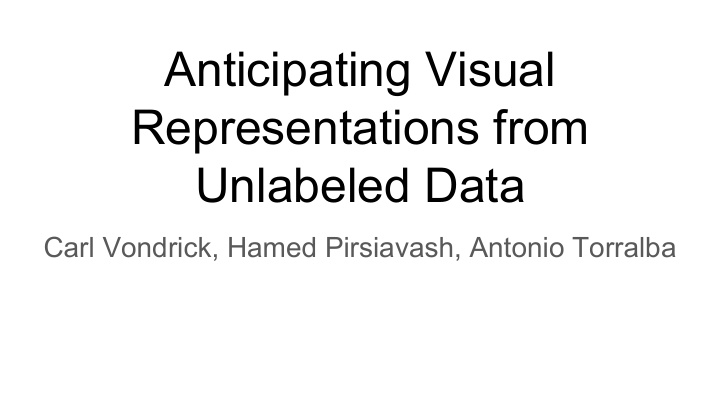



Anticipating Visual Representations from Unlabeled Data Carl Vondrick, Hamed Pirsiavash, Antonio Torralba
Overview ● Problem ● Key Insight ● Methods ● Experiments
Problem: Predict future actions and objects Image from Vondrick et. al, http://web.mit.edu/vondrick/prediction/paper.pdf
Related Work ● Unlabeled video prediction ○ Motion and trajectory prediction ○ Pixel level prediction ● Action prediction ○ Intention inference ○ Semantic context for action prediction ● Path and motion prediction ○ Optical flow
Applications ● Robotics ○ Path planning ○ Human robot interaction ○ Obstacle avoidance ● Surveillance ○ Warning systems
Overview ● Problem ● Key Insight ● Methods ● Experiments
Key Insight: Don’t predict images Image from Vondrick et. al, http://web.mit.edu/vondrick/prediction/paper.pdf
Key Insight: Predict Intermediate Representation Predict AlexNet Representation Image from Vondrick et. al, http://web.mit.edu/vondrick/prediction/paper.pdf
Key Insight: Predict Intermediate Representation Predict AlexNet Representation Classifier Image from Vondrick et. al, http://web.mit.edu/vondrick/prediction/paper.pdf
Overview ● Problem ● Key Insight ● Methods ● Experiments
Use Unlabeled Video as Training Data ● The internet is full of unlabeled videos ○ Used 600 hours of popular TV shows on YouTube ● Get supervision for free! (Because they all go forward in time) ○ ● Can then use predicted representation for action or object detection
Multiple Futures Image from Vondrick et. al, http://web.mit.edu/vondrick/prediction/paper.pdf
Multiple Futures ● Train network to predict K representations for the future ● Classify all K representations ● Predict class with highest marginal probability Image from Vondrick et. al, http://web.mit.edu/vondrick/prediction/paper.pdf
Network Architecture AlexNet fc7 ● Alexnet with additional fully connected layers ● Loss function is simply argmin of squared error. Image from Vondrick et. al, http://web.mit.edu/vondrick/prediction/paper.pdf
Overview ● Problem ● Key Insight ● Methods ● Experiments
Action Forecasting Experiment ● Dataset: TV Human Interactions ○ 300 separate videos ○ People do one of: {high fiving, hugging, shaking hands, kissing} ● Goal: Predict activity 1 second in the future ● Baselines: ○ SVM, Nearest Neighbor, Max Margin Event Detector, Linear Regression
Normal vs. Adapted Training: Normal Training Ground Truth Future Representation Classifier Image from Vondrick et. al, http://web.mit.edu/vondrick/prediction/paper.pdf
Normal vs. Adapted Training: Adapted Training Ground Truth Future Representation CNN Future Predictor Classifier Predicted Future Representation Image from Vondrick et. al, http://web.mit.edu/vondrick/prediction/paper.pdf
Action Forecasting Results ● Deep, adapted networks outperform all baselines ● Much effort needed to approach human-level performance
Action Forecasting Results
Action Forecasting Results?
Object Forecasting Experiment ● Dataset: Daily Living Activities Dataset ○ Egocentric video ○ Segments featuring 1 of 14 objects ● Goal: Predict object on screen 5 seconds in the future ● Baselines: ○ SVM, Scene features, Linear Classifier ● Normal & Adapted, as before
Object Forecasting Results ● Performance indicates that this is a difficult task ○ Still, outperformed all other methods.
Object Forecasting Results Image from Vondrick et. al, http://web.mit.edu/vondrick/prediction/paper.pdf
Future Work ● More robust experimentation ○ Comparison to other action prediction systems ○ Improved performance on egocentric dataset ○ Datasets (i.e. THUMOS) where semantic roles are not implicit ● Extension to real world problems ○ Robotics, surveillance, etc. ● Video Generation
Conclusion ● Problem ○ Predicting future actions or objects in video ● Key Insight ○ Learn to predict intermediate representations from unlabeled data ● Methods ○ AlexNet with additional FC layers ● Experiments ○ Outperformed baselines on action detection, still work to do to reach human performance ○ Object forecasting results proved to be challenging, still outperformed baselines
The End.
Recommend
More recommend